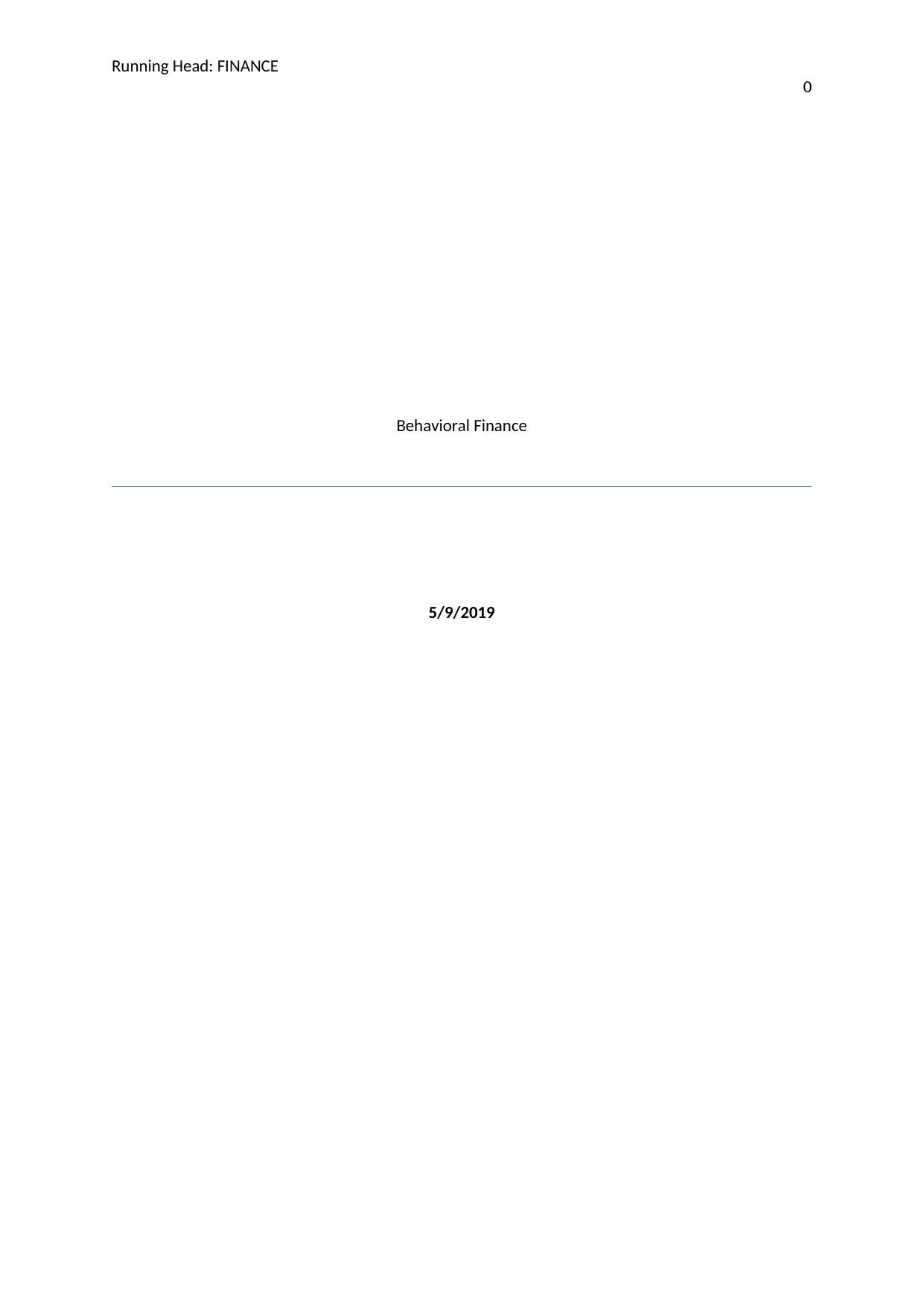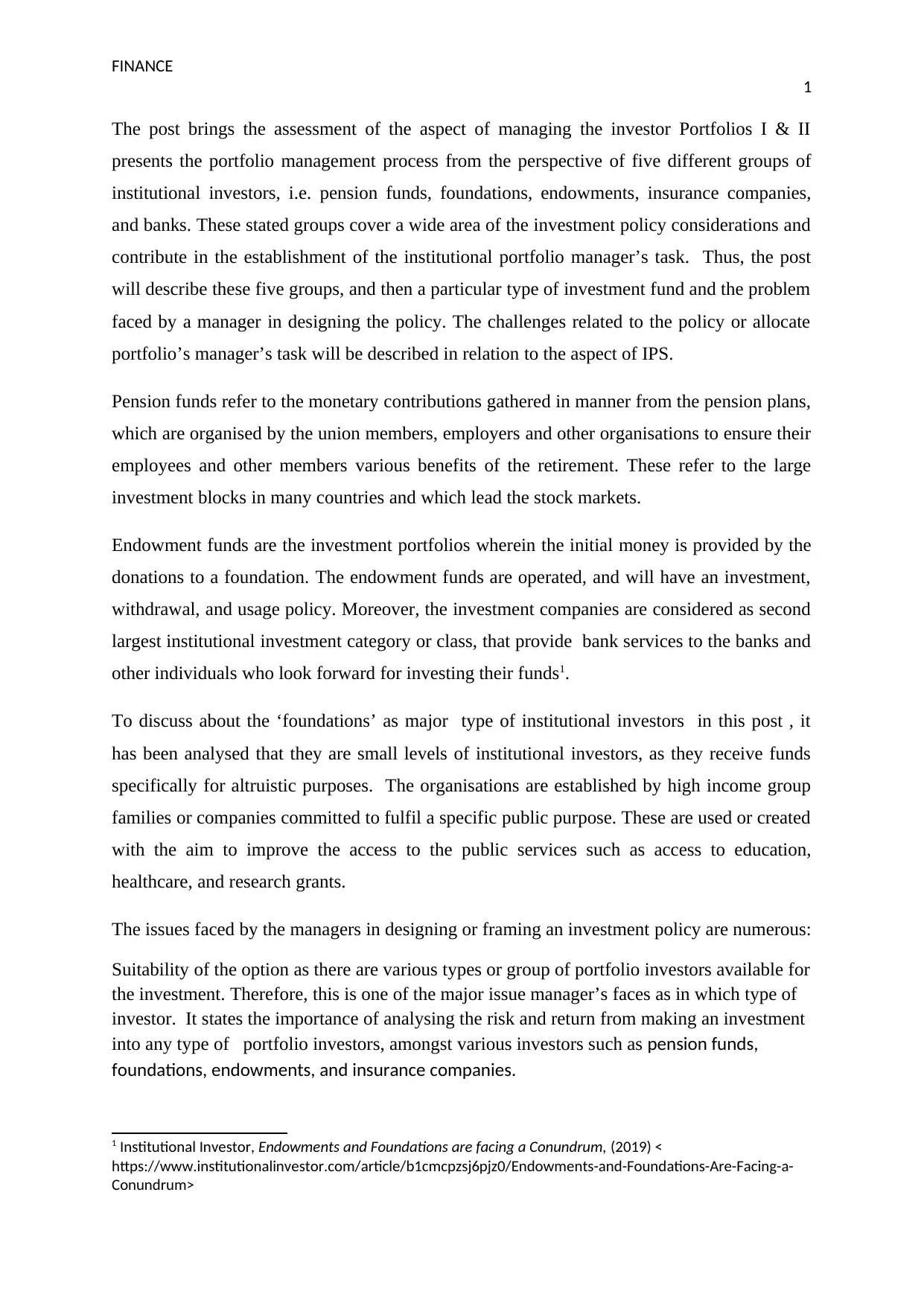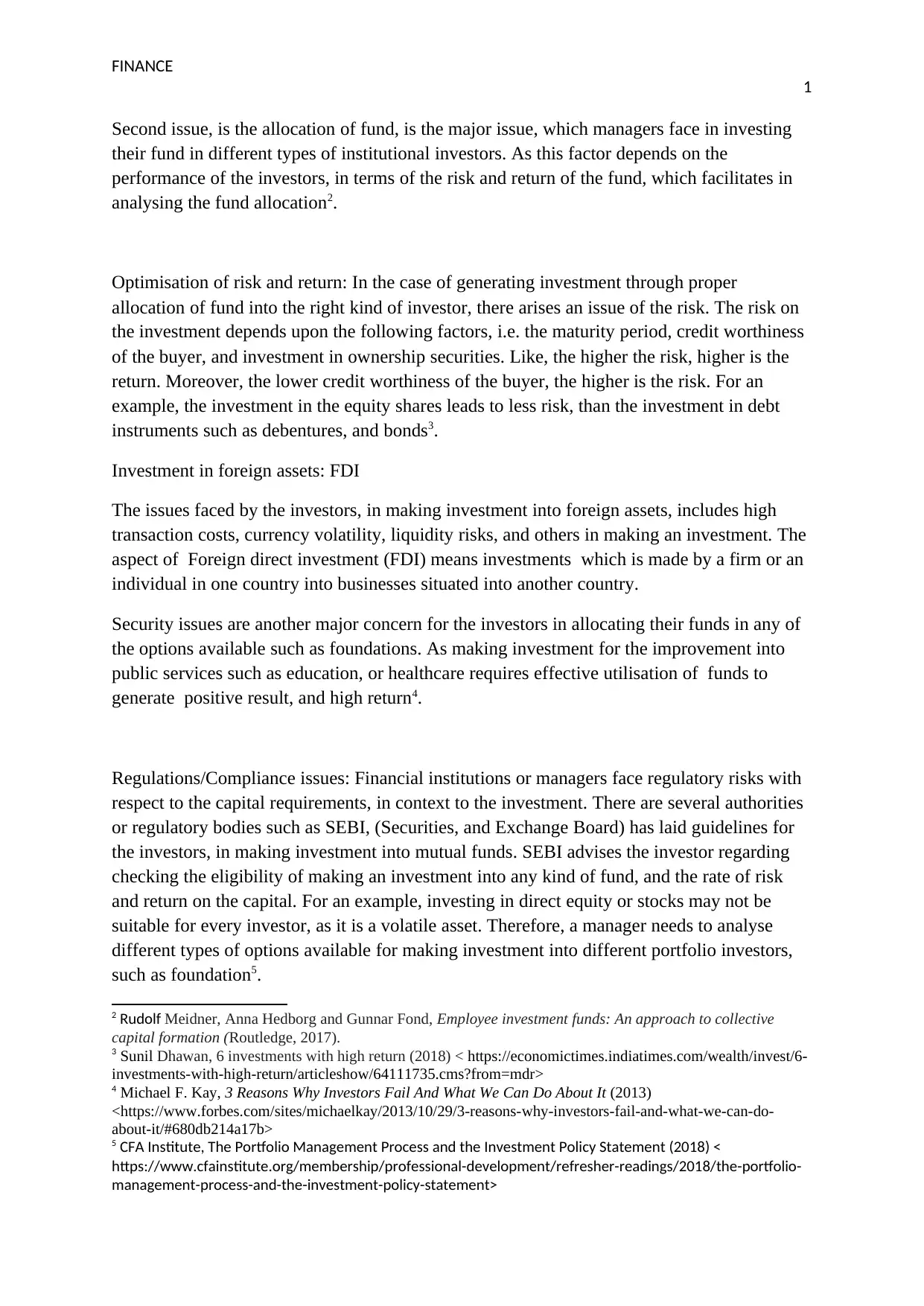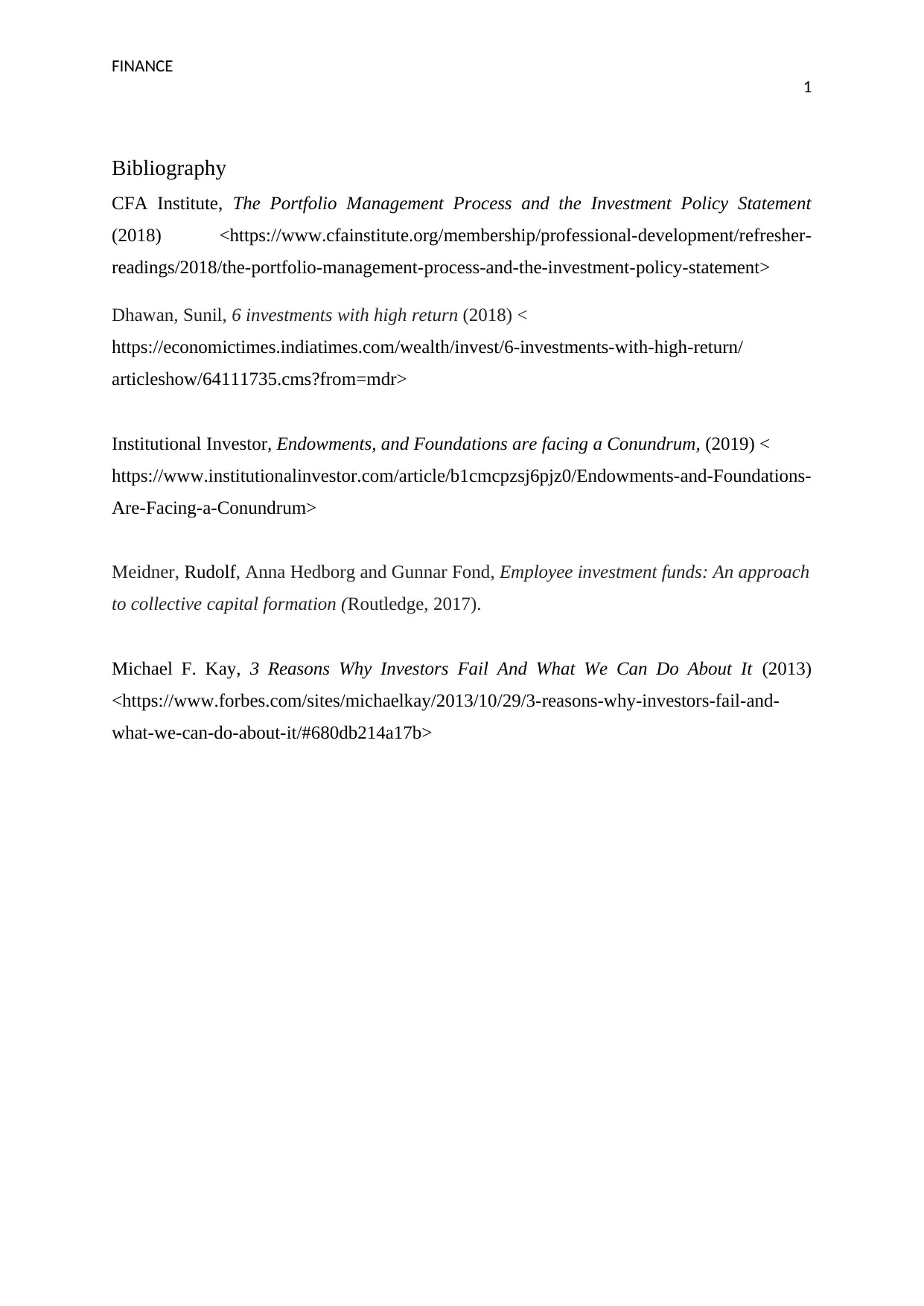Finance 1: Analysis of Institutional Investor Portfolio Management
VerifiedAdded on 2023/01/17
|5
|1180
|95
Discussion Board Post
AI Summary
This discussion board post analyzes the challenges faced by managers of institutional investor portfolios, focusing on the perspective of five different groups: pension funds, foundations, endowments, insurance companies, and banks. The post explores the complexities of investment policy considerations and the challenges faced by institutional portfolio managers. It discusses issues such as fund allocation, optimization of risk and return, investments in foreign assets, security concerns, and regulatory compliance. The analysis highlights the importance of considering factors like the suitability of investment options, risk assessment, and compliance with regulations when making investment decisions. The author synthesizes content knowledge and publicly available information to provide an evidence-based synopsis of the issues related to the Investment Policy Statement (IPS) and the specific challenges faced by managers of these diverse types of funds.

Running Head: FINANCE
0
Behavioral Finance
5/9/2019
0
Behavioral Finance
5/9/2019
Paraphrase This Document
Need a fresh take? Get an instant paraphrase of this document with our AI Paraphraser

FINANCE
1
The post brings the assessment of the aspect of managing the investor Portfolios I & II
presents the portfolio management process from the perspective of five different groups of
institutional investors, i.e. pension funds, foundations, endowments, insurance companies,
and banks. These stated groups cover a wide area of the investment policy considerations and
contribute in the establishment of the institutional portfolio manager’s task. Thus, the post
will describe these five groups, and then a particular type of investment fund and the problem
faced by a manager in designing the policy. The challenges related to the policy or allocate
portfolio’s manager’s task will be described in relation to the aspect of IPS.
Pension funds refer to the monetary contributions gathered in manner from the pension plans,
which are organised by the union members, employers and other organisations to ensure their
employees and other members various benefits of the retirement. These refer to the large
investment blocks in many countries and which lead the stock markets.
Endowment funds are the investment portfolios wherein the initial money is provided by the
donations to a foundation. The endowment funds are operated, and will have an investment,
withdrawal, and usage policy. Moreover, the investment companies are considered as second
largest institutional investment category or class, that provide bank services to the banks and
other individuals who look forward for investing their funds1.
To discuss about the ‘foundations’ as major type of institutional investors in this post , it
has been analysed that they are small levels of institutional investors, as they receive funds
specifically for altruistic purposes. The organisations are established by high income group
families or companies committed to fulfil a specific public purpose. These are used or created
with the aim to improve the access to the public services such as access to education,
healthcare, and research grants.
The issues faced by the managers in designing or framing an investment policy are numerous:
Suitability of the option as there are various types or group of portfolio investors available for
the investment. Therefore, this is one of the major issue manager’s faces as in which type of
investor. It states the importance of analysing the risk and return from making an investment
into any type of portfolio investors, amongst various investors such as pension funds,
foundations, endowments, and insurance companies.
1 Institutional Investor, Endowments and Foundations are facing a Conundrum, (2019) <
https://www.institutionalinvestor.com/article/b1cmcpzsj6pjz0/Endowments-and-Foundations-Are-Facing-a-
Conundrum>
1
The post brings the assessment of the aspect of managing the investor Portfolios I & II
presents the portfolio management process from the perspective of five different groups of
institutional investors, i.e. pension funds, foundations, endowments, insurance companies,
and banks. These stated groups cover a wide area of the investment policy considerations and
contribute in the establishment of the institutional portfolio manager’s task. Thus, the post
will describe these five groups, and then a particular type of investment fund and the problem
faced by a manager in designing the policy. The challenges related to the policy or allocate
portfolio’s manager’s task will be described in relation to the aspect of IPS.
Pension funds refer to the monetary contributions gathered in manner from the pension plans,
which are organised by the union members, employers and other organisations to ensure their
employees and other members various benefits of the retirement. These refer to the large
investment blocks in many countries and which lead the stock markets.
Endowment funds are the investment portfolios wherein the initial money is provided by the
donations to a foundation. The endowment funds are operated, and will have an investment,
withdrawal, and usage policy. Moreover, the investment companies are considered as second
largest institutional investment category or class, that provide bank services to the banks and
other individuals who look forward for investing their funds1.
To discuss about the ‘foundations’ as major type of institutional investors in this post , it
has been analysed that they are small levels of institutional investors, as they receive funds
specifically for altruistic purposes. The organisations are established by high income group
families or companies committed to fulfil a specific public purpose. These are used or created
with the aim to improve the access to the public services such as access to education,
healthcare, and research grants.
The issues faced by the managers in designing or framing an investment policy are numerous:
Suitability of the option as there are various types or group of portfolio investors available for
the investment. Therefore, this is one of the major issue manager’s faces as in which type of
investor. It states the importance of analysing the risk and return from making an investment
into any type of portfolio investors, amongst various investors such as pension funds,
foundations, endowments, and insurance companies.
1 Institutional Investor, Endowments and Foundations are facing a Conundrum, (2019) <
https://www.institutionalinvestor.com/article/b1cmcpzsj6pjz0/Endowments-and-Foundations-Are-Facing-a-
Conundrum>

FINANCE
1
Second issue, is the allocation of fund, is the major issue, which managers face in investing
their fund in different types of institutional investors. As this factor depends on the
performance of the investors, in terms of the risk and return of the fund, which facilitates in
analysing the fund allocation2.
Optimisation of risk and return: In the case of generating investment through proper
allocation of fund into the right kind of investor, there arises an issue of the risk. The risk on
the investment depends upon the following factors, i.e. the maturity period, credit worthiness
of the buyer, and investment in ownership securities. Like, the higher the risk, higher is the
return. Moreover, the lower credit worthiness of the buyer, the higher is the risk. For an
example, the investment in the equity shares leads to less risk, than the investment in debt
instruments such as debentures, and bonds3.
Investment in foreign assets: FDI
The issues faced by the investors, in making investment into foreign assets, includes high
transaction costs, currency volatility, liquidity risks, and others in making an investment. The
aspect of Foreign direct investment (FDI) means investments which is made by a firm or an
individual in one country into businesses situated into another country.
Security issues are another major concern for the investors in allocating their funds in any of
the options available such as foundations. As making investment for the improvement into
public services such as education, or healthcare requires effective utilisation of funds to
generate positive result, and high return4.
Regulations/Compliance issues: Financial institutions or managers face regulatory risks with
respect to the capital requirements, in context to the investment. There are several authorities
or regulatory bodies such as SEBI, (Securities, and Exchange Board) has laid guidelines for
the investors, in making investment into mutual funds. SEBI advises the investor regarding
checking the eligibility of making an investment into any kind of fund, and the rate of risk
and return on the capital. For an example, investing in direct equity or stocks may not be
suitable for every investor, as it is a volatile asset. Therefore, a manager needs to analyse
different types of options available for making investment into different portfolio investors,
such as foundation5.
2 Rudolf Meidner, Anna Hedborg and Gunnar Fond, Employee investment funds: An approach to collective
capital formation (Routledge, 2017).
3 Sunil Dhawan, 6 investments with high return (2018) < https://economictimes.indiatimes.com/wealth/invest/6-
investments-with-high-return/articleshow/64111735.cms?from=mdr>
4 Michael F. Kay, 3 Reasons Why Investors Fail And What We Can Do About It (2013)
<https://www.forbes.com/sites/michaelkay/2013/10/29/3-reasons-why-investors-fail-and-what-we-can-do-
about-it/#680db214a17b>
5 CFA Institute, The Portfolio Management Process and the Investment Policy Statement (2018) <
https://www.cfainstitute.org/membership/professional-development/refresher-readings/2018/the-portfolio-
management-process-and-the-investment-policy-statement>
1
Second issue, is the allocation of fund, is the major issue, which managers face in investing
their fund in different types of institutional investors. As this factor depends on the
performance of the investors, in terms of the risk and return of the fund, which facilitates in
analysing the fund allocation2.
Optimisation of risk and return: In the case of generating investment through proper
allocation of fund into the right kind of investor, there arises an issue of the risk. The risk on
the investment depends upon the following factors, i.e. the maturity period, credit worthiness
of the buyer, and investment in ownership securities. Like, the higher the risk, higher is the
return. Moreover, the lower credit worthiness of the buyer, the higher is the risk. For an
example, the investment in the equity shares leads to less risk, than the investment in debt
instruments such as debentures, and bonds3.
Investment in foreign assets: FDI
The issues faced by the investors, in making investment into foreign assets, includes high
transaction costs, currency volatility, liquidity risks, and others in making an investment. The
aspect of Foreign direct investment (FDI) means investments which is made by a firm or an
individual in one country into businesses situated into another country.
Security issues are another major concern for the investors in allocating their funds in any of
the options available such as foundations. As making investment for the improvement into
public services such as education, or healthcare requires effective utilisation of funds to
generate positive result, and high return4.
Regulations/Compliance issues: Financial institutions or managers face regulatory risks with
respect to the capital requirements, in context to the investment. There are several authorities
or regulatory bodies such as SEBI, (Securities, and Exchange Board) has laid guidelines for
the investors, in making investment into mutual funds. SEBI advises the investor regarding
checking the eligibility of making an investment into any kind of fund, and the rate of risk
and return on the capital. For an example, investing in direct equity or stocks may not be
suitable for every investor, as it is a volatile asset. Therefore, a manager needs to analyse
different types of options available for making investment into different portfolio investors,
such as foundation5.
2 Rudolf Meidner, Anna Hedborg and Gunnar Fond, Employee investment funds: An approach to collective
capital formation (Routledge, 2017).
3 Sunil Dhawan, 6 investments with high return (2018) < https://economictimes.indiatimes.com/wealth/invest/6-
investments-with-high-return/articleshow/64111735.cms?from=mdr>
4 Michael F. Kay, 3 Reasons Why Investors Fail And What We Can Do About It (2013)
<https://www.forbes.com/sites/michaelkay/2013/10/29/3-reasons-why-investors-fail-and-what-we-can-do-
about-it/#680db214a17b>
5 CFA Institute, The Portfolio Management Process and the Investment Policy Statement (2018) <
https://www.cfainstitute.org/membership/professional-development/refresher-readings/2018/the-portfolio-
management-process-and-the-investment-policy-statement>
⊘ This is a preview!⊘
Do you want full access?
Subscribe today to unlock all pages.

Trusted by 1+ million students worldwide

FINANCE
1
To conclude the above discussion of the post it has been analysed that investment into
different kinds of options available requires analysis of various types of factors. These consist
of security, risk and return rate from investing capital, allocation of fund into right stock, and
others. Hence, while making an investment the managers or investor must match their own
risk with the risk associated with the product.
1
To conclude the above discussion of the post it has been analysed that investment into
different kinds of options available requires analysis of various types of factors. These consist
of security, risk and return rate from investing capital, allocation of fund into right stock, and
others. Hence, while making an investment the managers or investor must match their own
risk with the risk associated with the product.
Paraphrase This Document
Need a fresh take? Get an instant paraphrase of this document with our AI Paraphraser

FINANCE
1
Bibliography
CFA Institute, The Portfolio Management Process and the Investment Policy Statement
(2018) <https://www.cfainstitute.org/membership/professional-development/refresher-
readings/2018/the-portfolio-management-process-and-the-investment-policy-statement>
Dhawan, Sunil, 6 investments with high return (2018) <
https://economictimes.indiatimes.com/wealth/invest/6-investments-with-high-return/
articleshow/64111735.cms?from=mdr>
Institutional Investor, Endowments, and Foundations are facing a Conundrum, (2019) <
https://www.institutionalinvestor.com/article/b1cmcpzsj6pjz0/Endowments-and-Foundations-
Are-Facing-a-Conundrum>
Meidner, Rudolf, Anna Hedborg and Gunnar Fond, Employee investment funds: An approach
to collective capital formation (Routledge, 2017).
Michael F. Kay, 3 Reasons Why Investors Fail And What We Can Do About It (2013)
<https://www.forbes.com/sites/michaelkay/2013/10/29/3-reasons-why-investors-fail-and-
what-we-can-do-about-it/#680db214a17b>
1
Bibliography
CFA Institute, The Portfolio Management Process and the Investment Policy Statement
(2018) <https://www.cfainstitute.org/membership/professional-development/refresher-
readings/2018/the-portfolio-management-process-and-the-investment-policy-statement>
Dhawan, Sunil, 6 investments with high return (2018) <
https://economictimes.indiatimes.com/wealth/invest/6-investments-with-high-return/
articleshow/64111735.cms?from=mdr>
Institutional Investor, Endowments, and Foundations are facing a Conundrum, (2019) <
https://www.institutionalinvestor.com/article/b1cmcpzsj6pjz0/Endowments-and-Foundations-
Are-Facing-a-Conundrum>
Meidner, Rudolf, Anna Hedborg and Gunnar Fond, Employee investment funds: An approach
to collective capital formation (Routledge, 2017).
Michael F. Kay, 3 Reasons Why Investors Fail And What We Can Do About It (2013)
<https://www.forbes.com/sites/michaelkay/2013/10/29/3-reasons-why-investors-fail-and-
what-we-can-do-about-it/#680db214a17b>
1 out of 5
Related Documents
Your All-in-One AI-Powered Toolkit for Academic Success.
+13062052269
info@desklib.com
Available 24*7 on WhatsApp / Email
![[object Object]](/_next/static/media/star-bottom.7253800d.svg)
Unlock your academic potential
Copyright © 2020–2025 A2Z Services. All Rights Reserved. Developed and managed by ZUCOL.




